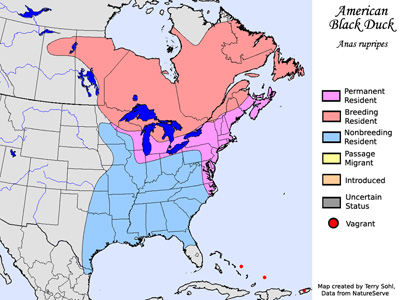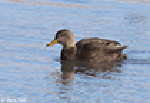American Black Duck
Anas rubripes
| Length: 20 - 24 inches | Wingspan: 32 - 36 inches | Seasonality: Rare Migrant |
| ID Keys: Both sexes similar to female Mallard, but much darker body and gray head. | ||
 The American Black Duck is a close relative of the Mallard,
but is more often found in wooded habitats. Competition with Mallards,
along with habitat loss caused by forest clearing, has steadily eroded their
range. Their stronghold has now been reduced to the Northeastern U.S., and
they are becoming less and less common on the interior of the country.
The American Black Duck is a close relative of the Mallard,
but is more often found in wooded habitats. Competition with Mallards,
along with habitat loss caused by forest clearing, has steadily eroded their
range. Their stronghold has now been reduced to the Northeastern U.S., and
they are becoming less and less common on the interior of the country.
In South Dakota, they are rare visitors, with most sightings in the far eastern edge of the state. Most sightings occur during migration.
Habitat:
Found in a wide variety of aquatic habitats, but usually prefers woodland ponds and coastal salt marshes.
Diet:
Omnivorous. May feed on seeds, leaves, roots, berries, and aquatic plants, as well as crustaceans, mollusks, and insects.
Behavior:
A dabbling duck, nearly always feeding by upending, only very rarely diving. They will also forage on land by waddling around, grazing on plant material and sometimes digging for roots.
Breeding:
Non-breeder in South Dakota. In their breeding range, American Black Ducks will use a very wide range of potential nesting sites. Nests are primarily constructed on the ground, usually near water, in a protected area that may be at the base of a shrub or clump of herbaceous vegetation, in the shadow of a rock, under a tree, or other object or element of vegetation that helps to partially conceal the nest. Less often, American Black Ducks may nest in an open cavity of a tree or the top of a low stump or snag. The nest is a shallow scrape lined with bits of whatever vegetation are close to the nesting site. The female lays eggs one at a time, with one egg each day, with total clutch size typically between 6 and 13. As she lays eggs, she begins to line the nest with down, providing more warmth and protection for the eggs.
The female incubates the eggs herself. The male may stay around the nest site and help defend it, but by the time the eggs hatch, the male has typically departed. Incubation lasts about 30 days. The young leave the nest within a day of hatching, with the female leading them to feeding grounds and tending to them. The young are responsible for gathering their own food until they fledge.
Interactive eBird Map:
Click to access an interactive eBird map of American Black Duck sightings
Song:
Typical quack from female, lower croaking from the male.
1Click here to hear the call of a female American Black Duck taking flight
2Click here to hear the alarm call of an American Black Duck
Migration:
Summers through much of the Northeastern U.S., the Great Lakes region, and eastern Canada. Winters in the eastern United States. Inland birds and those in Canada migrate fairly long distances, but those along the coast and in the southern part of their range may migrate very little.
Similar Species:
American Black Ducks can be confusing for a birder as they don't have the same dramatic difference in plumage between males and females as do most other duck species. Their relatively plain plumage overall primarily results in identification challenges with female ducks of other species. The following are the species most likely to be confused with an American Black Duck.
- Mallard - Given that the two species are often found in close proximity to each other, Mallards are the species most likely to be confused with American Black Ducks. The overall plain plumage of an American Black Duck may superficially give the impression of a female Mallard, but the body of an American Black Duck is darker with less contrasting markings. The bill is the easiest way to differentiate between the two, as a female Mallard has an orange bill with dark mark markings, while the bill of an American Black Duck is yellowish. Note the colored speculum on the wing also differentiates the two species, but generally good light and viewing conditions are needed to use it for identification. American Black Ducks have a purplish-colored speculum, while it's blue on a Mallard.
- Mottled Duck - Mottled Ducks are the species most similar in appearance to the American Black Duck. However, the potential overlap in range between the two species is small, and generally confined to the winter months when migrating American Black Ducks may move southward far enough to come into the Gulf Coast and Florida range of the Mottled Duck. In terms of appearance, facial plumage is the easiest way to tell the two species apart, as Mottled Ducks have a plainer, less-patterned, buffy looking face, while American Black Ducks have a less colorful tan face with fine darker streaking. Mottled Ducks are also typically lighter in tone on the body than an American Black Duck.
- Gadwall - Given the relatively plain plumage on both male and female Gadwalls, they could potentially be confused with an American Black Duck. However, both male and female Gadwalls have lighter coloring on the body, and both sexes lack the colorful speculum of the American Black Duck. The bill colors also differ, with Gadwall males having a dark bill, and Gadwall females having an orange and black bill (compare to yellow bill of American Black Duck).
Conservation Status:
Forest destruction has decimated populations of American Black Ducks in inland areas, as the current landscape in many areas favors the more adaptable Mallard over American Black Ducks. Hybridization with Mallards has also taken its toll, as the two species readily interbreed in eastern North America. The problem has become much more pronounced in the last 100 years, as Mallards historically weren't found as a breeding bird in the northeastern US and southeastern Canada, but are now widely spread throughout North America.
However, despite substantial declines in overall numbers of American Black Duck in the last several decades, they are still found over a broad geographic area, and are common in many parts of their range. The IUCN considers the American Black Duck to be a species of "Least Concern".
Further Information:
1) WhatBird - American Black Duck
2) Ducks Unlimited - American Black Duck
3) Audubon Guide - American Black Duck
Photo Information: November 24th, 2018 - Sioux Falls, South Dakota - Terry Sohl.
Audio File Credits:
1Andrew Spencer. Recorded in Plymouth County, Massachusetts on November 16th, 2014. Original recording and information available on xeno-canto.
2Martin St. Michel. Recorded in Quebec on July 14th, 2013. Original recording and information available on xeno-canto.
| Click on the range map for a higher-resolution view |
 |
| South Dakota Status: Rare migrant in the eastern half of the state. Accidental in other seasons and in all seasons in the western half of the state. |
Additional American Black Duck Photos




